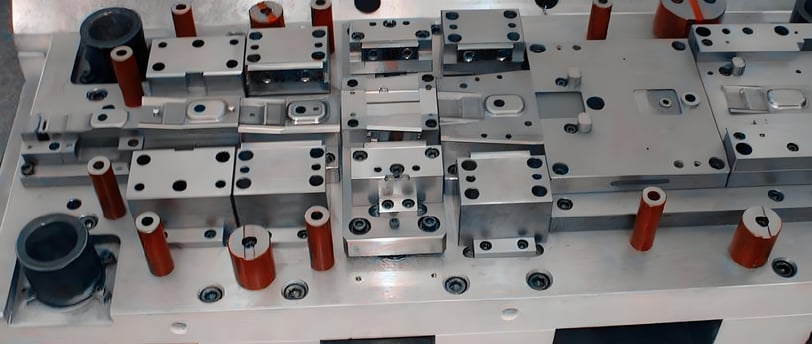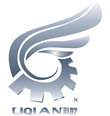Economy and Productivity Improvement Strategies for Stamping Tooling
2/18/2025


Understanding Stamping Tooling and Its Economic Impact
Stamping tooling refers to the equipment, dies, and machinery used in the metal stamping process to shape and cut materials into desired forms. This process is pivotal in various manufacturing sectors, particularly automotive, aerospace, and electronics, where precision and efficiency are paramount. The economic impact of stamping tooling is significant, as it directly affects productivity, cost-effectiveness, and overall product quality.
There are several types of stamping tools, including progressive dies, transfer dies, and single-station dies, each serving unique purposes in manufacturing. Progressive dies are designed for high-volume production, enabling multiple operations to be performed in a single setup, which enhances efficiency. Transfer dies, on the other hand, allow for complex shapes to be formed by transferring materials from one station to another. Finally, single-station dies serve simpler tasks, often utilized for low-volume or prototype production. The choice of tooling directly influences production speed, material waste, and labor costs, which are critical for maintaining competitiveness in today's economy.
Effective stamping tooling can lead to significant cost savings, as it minimizes scrap material and reduces cycle times. Improved tooling designs also enhance the quality and consistency of the finished products, leading to higher customer satisfaction and reduced warranty claims. In the current economic landscape, where businesses face rising costs and increasing competition, investing in advanced stamping tooling technologies becomes essential. These investments not only streamline operations but also position companies to respond effectively to market demands, ultimately bolstering their economic standing.
In essence, understanding the intricacies of stamping tooling and its broader implications is crucial for manufacturers aiming to optimize their operations and achieve sustainable economic performance.
Key Strategies for Enhancing Productivity in Stamping Tooling
Enhancing productivity in stamping tooling is essential for manufacturers aiming to remain competitive in a dynamic market. One of the foremost strategies is the implementation of automation. By integrating advanced technologies, such as robotics and automated workflows, businesses can significantly reduce cycle times and increase output. For instance, auto parts manufacturers have witnessed a remarkable decrease in production times by using automated presses that can operate continuously, minimizing human error and enabling 24/7 production.
Another critical approach is the application of lean manufacturing principles. By focusing on the elimination of waste and streamlining processes, companies can optimize their resource utilization. Implementing techniques such as value stream mapping allows organizations to identify activities that do not add value and modify them accordingly. A notable example is a leading stamping company that adopted lean practices, which led to a 25% reduction in lead time and a drastic drop in operational costs.
Furthermore, investing in employee training and development is paramount for enhancing productivity. Skilled workers are essential for effective operation and problem-solving within the stamping process. By providing regular training programs and workshops, companies can ensure that their workforce is proficient in the latest techniques and technologies. One prominent manufacturer reported that after enhancing employee skill sets through continuous education initiatives, they saw a 30% improvement in productivity due to reduced downtime and error rates.
Incorporating these strategies—automation, lean manufacturing principles, and substantial investment in training—can yield significant results in terms of productivity in stamping tooling operations. Companies that implement these recommendations not only enhance their performance metrics but also foster a culture of continuous improvement, positioning themselves for long-term success in the competitive landscape of manufacturing.
Cost Reduction Techniques in Stamping Tooling Operations
The stamping tooling industry is continually challenged to minimize costs while enhancing production efficiency. Implementing effective cost reduction techniques in stamping tooling operations can significantly impact the bottom line. One critical approach is material optimization. This entails selecting the appropriate materials that not only meet requirements but also offer cost efficiencies. Utilizing advanced materials that are lighter yet stronger may lead to reductions in scrap rates and enhance overall productivity.
Another essential technique is the adoption of maintenance best practices. Preventive maintenance schedules should be established, ensuring tools are inspected and serviced regularly. This proactive approach minimizes the risk of unexpected breakdowns that could result in costly delays. Additionally, proper maintenance can extend the life of stamping tools, thereby reducing the frequency of equipment replacement. Ensuring that tools are in optimal condition creates a more stable production environment and helps maintain high-quality output, which is essential for reducing costs.
Moreover, focusing on proper tool design plays a significant role in minimizing waste and downtime. Engineers should emphasize incorporating features into the tool design that enhance functionality and ease of setup. Streamlining designs to minimize the number of parts can not only help in reducing material costs but also facilitate quicker assembly and disassembly, leading to less time spent changing tools between jobs. Such efficiencies can dramatically lower production costs while ensuring customer satisfaction through timely deliveries.
The financial implications of these cost reduction techniques are substantial. By optimizing material usage, adhering to maintenance schedules, and investing in sound tool designs, businesses can significantly enhance profitability. Ultimately, the successful implementation of these strategies in stamping tooling operations not only helps in curtailing unnecessary expenses but also fosters a culture of continuous improvement, paving the way for long-term sustainability and growth.
Future Trends in Stamping Tooling and Productivity Enhancement
The stamping tooling industry is on the brink of transformation, driven by a confluence of technological advancements and evolving manufacturing practices. Among the most significant developments is the adoption of Industry 4.0 principles, which emphasizes the interconnectivity of machinery, data analytics, and automation. This paradigm shift allows for real-time monitoring and management of stamping processes, ultimately leading to increased efficiency and productivity in tooling operations. By leveraging data collected from various stages of the production line, manufacturers can fine-tune their processes, reducing waste and improving overall output.
An integral aspect of Industry 4.0 is smart manufacturing, which capitalizes on the Internet of Things (IoT) to create intelligent and responsive production environments. In the context of stamping tooling, this includes the integration of sensors and smart systems that can predict tool wear, optimize performance, and facilitate maintenance. Manufacturers that embrace smart technology can achieve heightened operational efficiency and minimize unplanned downtimes, which are critical factors in maintaining competitive advantage in the market.
Additionally, the incorporation of artificial intelligence (AI) into stamping processes represents another frontier in productivity enhancement. AI algorithms can analyze vast amounts of data generated during the stamping process to detect patterns and anomalies. This capability enables predictive maintenance, optimal scheduling of tooling operations, and enhanced quality control. By automating routine tasks and decision-making processes, organizations can allocate resources more efficiently, leading to increased economic benefits.
To remain competitive in an evolving landscape, it is essential for companies in the stamping industry to stay abreast of these emerging trends and technologies. By investing in innovative solutions like Industry 4.0, smart manufacturing, and AI-driven tools, manufacturers can ensure the longevity of their operations and achieve substantial productivity improvement, which is critical in meeting the demands of a rapidly changing marketplace.
